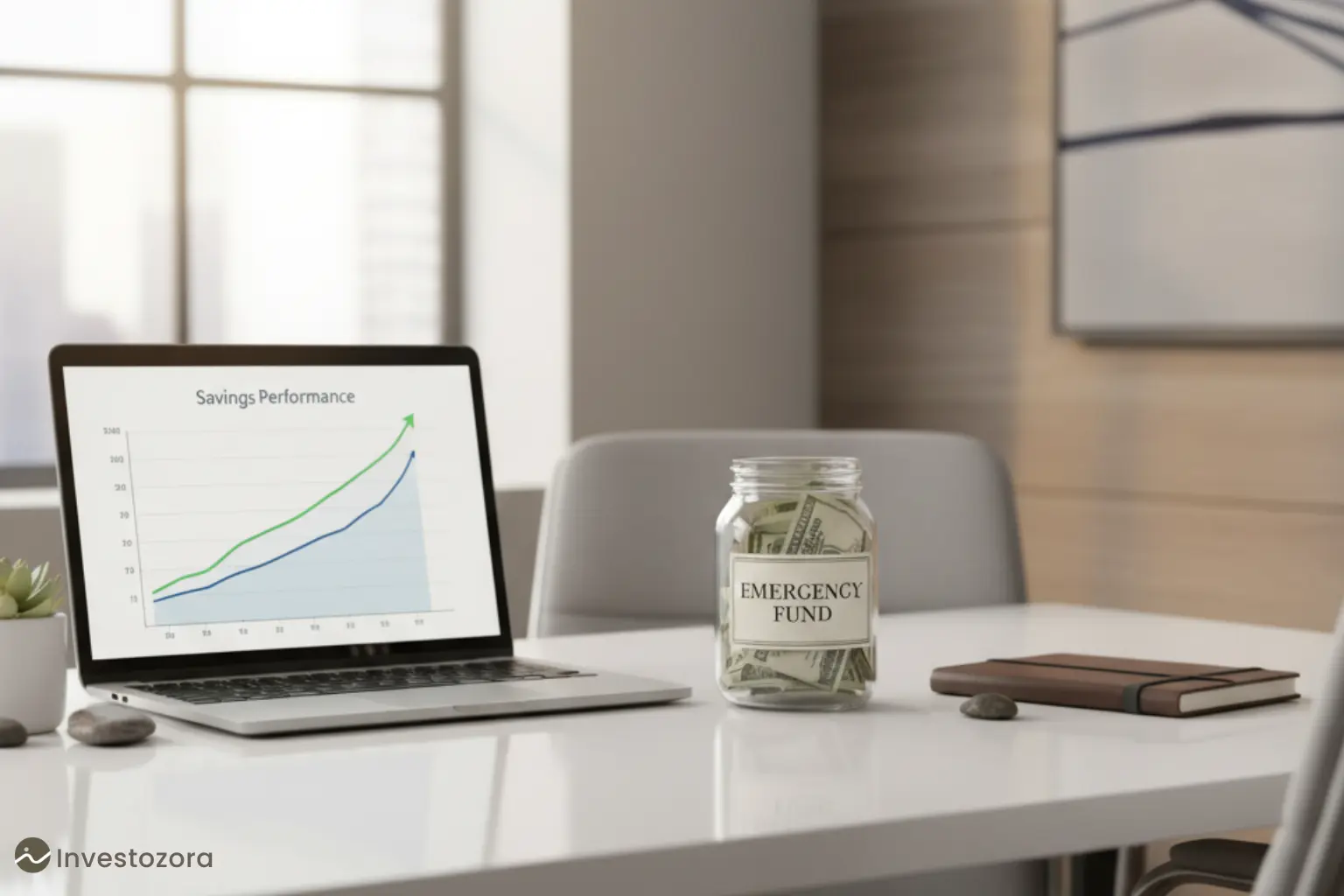Building a strong emergency fund is one of the smartest financial moves you can make in 2025. Life is unpredictable medical bills, job loss, or urgent home repairs can strike without warning and without savings, many Americans turn to credit cards or loans to stay afloat.
An emergency fund acts as your personal safety net, giving you peace of mind and financial stability when the unexpected happens. In this guide, we’ll explain how much to save, the best places to keep it, and practical steps to build your fund.
- An emergency fund is cash set aside for unexpected expenses like job loss, medical bills, or urgent repairs.
- Experts in 2025 recommend saving at least three to six months of essential expenses, and up to twelve in high-cost or unstable situations.
- The safest places to store funds are FDIC insured accounts such as high-yield savings, money market accounts, or short-term CDs.
- Start small—$500 or $1,000 and build steadily with automated transfers, cost-cutting, and windfalls like tax refunds.
- Replenish your fund quickly after use to maintain financial stability and avoid turning to credit cards or loans.
What Is an Emergency Fund and Why Do You Need One?
An emergency fund is cash you set aside only for life’s surprises. Unlike money in a regular bank account, this fund isn’t for vacations, shopping, or even planned bills.
It exists as a safety net when the unexpected happens like losing your job, paying for sudden medical care, or covering urgent car repairs. In 2025, when living costs remain high and the economy feels uncertain, having an emergency fund gives you security that everyday savings simply can’t.
Without one, many people rely on high-interest credit cards or risky personal loans to get through tough times. That quick fix often leads to long-term debt. The Consumer Financial Protection Bureau warns that households without savings face more financial stress and fewer options when emergencies strike.
Imagine a $2,000 car repair if you put it on a credit card with a 25% APR, you could still be paying for it years later. With an emergency fund, you cover it instantly and move forward without interest piling up.
Keeping your fund separate makes it easier to protect. Some people even use a dedicated business bank account to avoid dipping into the money by mistake. The ultimate goal is stability: when you have savings ready, you don’t have to touch retirement accounts, sell investments, or panic about bills.
It’s the first building block before diving into investing or setting up tax-free strategies. In short, an emergency fund gives you breathing room and control when life feels unpredictable.
How Much Should You Really Save in 2025?
Most experts suggest keeping three to six months of essential expenses in your emergency fund. That includes rent or mortgage, groceries, utilities, and insurance not extras like vacations.
For example, if your monthly bills total $3,000, you should aim for $9,000 to $18,000. If that sounds impossible, start with $500. Even a small cushion helps you avoid putting emergencies on a high-interest credit card.
In 2025, higher living costs mean many households need more than the old rule. Gig workers, single-income families, or people in expensive states often aim for nine to twelve months of expenses.
The Federal Reserve notes that nearly 40% of Americans struggle with a $400 emergency, showing why a larger buffer matters. Your exact number depends on your lifestyle. If you carry student loans or support dependents, save more.
You can also get guidance from a financial planner or balance your savings with tax-free strategies. Borrowing through personal loans can help temporarily, but building your own emergency fund keeps you in control.
Where Is the Best Place to Keep Your Emergency Fund?
The best place for your emergency fund is somewhere safe, liquid, and easy to access. You don’t want this money tied up in risky investments or accounts with withdrawal penalties. That’s why many Americans choose a high-yield savings account.
It earns more interest than a standard savings account, but you can still move money quickly when an emergency happens. Online banks often offer higher rates, making them a strong option in 2025.
Another smart choice is a money market account or a short-term certificate of deposit (CD). A business checking account with competitive interest can also work if you prefer to keep funds separate from personal savings.
Just make sure you’re not sacrificing access if you lock your emergency money in a five-year CD or long-term investment, you might pay penalties to withdraw it when you need it most.
Above all, safety comes first. The Federal Deposit Insurance Corporation (FDIC) insures deposits up to $250,000 per bank, per depositor. Keeping your fund in an FDIC-insured account ensures your money is protected even if the bank fails.
Avoid storing your emergency savings in the stock market, crypto, or retirement accounts like IRAs or 401(k)s. Those carry risks, taxes, or penalties that defeat the purpose of quick, reliable cash.
When you store your emergency fund in the right place, you earn interest while knowing the money is ready the moment life takes a turn.
How to Build (and Rebuild) an Emergency Fund Step by Step
Before jumping into steps, set yourself up to win. Pick a dedicated, FDIC-insured savings home a simple high-yield savings works so your emergency fund stays safe, liquid, and separate from day-to-day money. Define what “counts” as an emergency (job loss, medical bill, essential car/home repair) and write it down to avoid impulse dips.
Map your essential monthly costs so you know your target (3–6 months for most; more if income is irregular). If you want a second opinion on targets or trade-offs, talk to a financial planner. Lastly, commit to consistency: small, automatic contributions beat occasional big deposits.
Step 1: Start Small and Set Realistic Goals
An emergency fund can feel impossible if you picture thousands of dollars upfront. The trick is to start small. Even saving $25 each week adds up to $100 in a month and $1,200 in a year. Setting a realistic first goal like $500 or $1,000 makes the process less intimidating and gives you a quick win.
Once you hit that milestone, momentum builds. Remember, you’re not racing anyone; the goal is steady progress toward three to six months of essential expenses.
- Open a dedicated savings account so the money doesn’t mix with daily spending.
- Treat contributions like a bill you “owe” your future self this money.
- Use the CFPB’s budgeting tools to track and adjust expenses.
- Celebrate milestones: every $500 saved is a huge step toward independence.
- Keep perspective: even a small cushion saves you from turning to credit cards in a pinch.
Step 2: Automate Your Savings
Consistency beats motivation when it comes to saving. Automating your deposits ensures your emergency fund grows without requiring daily willpower. Once the transfer happens automatically, you won’t have to think about it and you’ll be less tempted to spend the money elsewhere.
This “set it and forget it” approach is why many people reach their savings goals faster than expected.
- Schedule an automatic transfer on payday so savings build before you start spending.
- Consider splitting your paycheck direct deposit part to checking, part to your fund.
- Use round-up apps that move spare change into savings every time you buy something.
- Store funds in a business bank account or secondary account to avoid accidental spending.
- Stick with it: automation makes saving consistent, even when life gets busy.
Step 3: Cut Costs and Redirect Cash
You don’t always need to earn more to save more you can redirect what you already spend. Cutting even $50 or $100 in nonessentials each month can significantly boost your emergency fund.
This doesn’t mean eliminating all fun but being intentional about where your dollars go. Every unnecessary expense you trim today strengthens your financial safety net tomorrow.
- Cancel unused subscriptions, streaming services, or memberships.
- Cook at home instead of eating out savings add up quickly.
- Refinance or consolidate student loans to lower payments and free up cash.
- Use balance transfer cards to cut interest costs and redirect savings.
- Apply cashback rewards or side hustle income directly to your emergency account.
Step 4: Avoid Tapping Into Your Fund for Non-Emergencies
The hardest part of having an emergency fund is resisting the urge to use it for non-essentials. A vacation, new furniture, or a holiday sale may feel urgent, but they’re not true emergencies.
Protecting your fund ensures it’s there when you genuinely need it like job loss, medical expenses, or necessary home repairs. The clearer your definition of “emergency,” the easier it is to leave your savings untouched.
- Decide in advance what qualifies: car repair, medical bill, or job loss not a shopping spree.
- Keep money in a high-yield account to separate it from daily spending.
- Use insurance coverage for predictable risks like health, home, or renters’ issues.
- Remind yourself: your fund is survival money, not convenience cash.
- Tell a trusted partner your rules so you stay accountable.
Step 5: Rebuild Quickly After Using It
Emergencies are exactly why you saved this money so don’t feel guilty when you spend it. The important part is rebuilding right away.
Think of replenishing your emergency fund as resetting your safety net. The faster you replace what you used, the sooner you regain financial stability and peace of mind.
- Increase your automatic transfers temporarily until you’ve replaced the withdrawn amount.
- Direct windfalls like tax refunds, bonuses, or side income straight into your savings.
- Work with a financial planner if you had to drain a large portion of your fund.
- Review your paycheck withholdings using IRS guidelines; small adjustments can free up cash.
- Rebuilding is momentum: once you restart, it becomes easier to stay consistent.
Bottom Line
An emergency fund isn’t just another savings goal it’s the backbone of financial security. By keeping three to six months of essential expenses in a safe, liquid account, you protect yourself from job loss, medical bills, or surprise car repairs without falling into debt. Start small, automate deposits, and rebuild quickly whenever you use it.
Whether you lean on a high-yield savings account or explore tax-free strategies, the key is consistency. Every dollar saved strengthens your independence and gives you the breathing room to handle life’s curveballs with confidence.
Methodology
This guide draws on best practices recommended by financial regulators and credible institutions, including data from the Federal Reserve and resources from the Consumer Financial Protection Bureau. We analyzed common savings rules, such as the three-to-six-month guideline, and adjusted for 2025 realities like inflation and rising living costs.
Internal examples link to practical tools such as personal loans, student loan refinancing, and insurance coverage to show how readers can balance emergencies with broader financial planning. The goal: clear, actionable advice written for U.S. households seeking stability.
Investozora uses only trusted, verified sources. We focus on government sites, official guidance, and first-hand data so readers get accurate, up-to-date information. All facts are checked against primary sources.
- Consumer Financial Protection Bureau (CFPB) – “Consumer Protection Guidance.”
- Federal Reserve – “Survey of Household Economics and Decisionmaking.”
- Federal Deposit Insurance Corporation (FDIC) – “Deposit Insurance.”
- Consumer Financial Protection Bureau (CFPB) – “Budgeting Tools.”
- Internal Revenue Service (IRS) – “Credits and Deductions.”
Frequently Asked Questions
-
The information on this site is for educational and general guidance only. It is not intended as financial, legal, or investment advice. Always consult a licensed professional for advice specific to your situation. We do not guarantee the accuracy, completeness, or suitability of any content.





